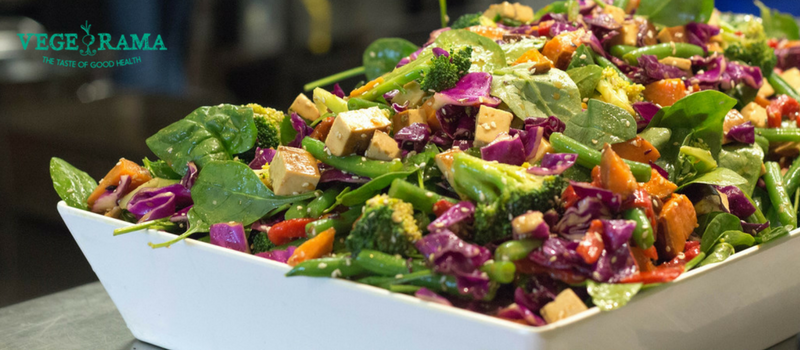4 Differences Between Healthy & Unhealthy Salads

Did you know that salads could be unhealthy? There are a variety of restaurants that offer salads, but not all of them are created equal. Here at Vege Rama, we specialize in fresh and delicious food. That is why we’ve created a Salad 101 checklist for you, so that next time you order one you’ll know that it is actually healthy.
Freshness
Many fast-food salads use stored produce and packaged ingredients that affect its flavour and nutrient content. In contrast with their processed counterparts, fresh fruits and vegetables are higher in fibre, have nutrients only available in their natural form, and do not contain high amounts of sugar, sodium or additives. So when you eat fresh foods you are actually getting all the nutrients and minerals that are good for you in addition to the delicious flavours.
Processes of Fast-food Salad Chains
When food is mass-produced and stored, it normally requires artificial and natural flavours to add taste. The mass-production process also affects the nutritional value and safety of fast food. Some fast food restaurants in particular spray their salads with propylene glycol to keep leaves crisp. Other chemicals can also be added to food to keep it “looking fresh” for longer.
Additives / Preservatives
Many salads include products with additives and preservatives that may cause sensitivity, allergies, and other health issues like digestive, nervous, respiratory and skin disorders. The most common items that contain these chemicals are packaged salad dressings and canned or bottled products. Thus, it is recommended to use homemade dressings and fresh salad ingredients.
Packaging
There is no doubt that packaging is a huge concern for our planet. Nowadays, fast food packaging counts for an estimated 40 per cent of all litter and waste products, but did you know this could also affect your health? According to the Centres for Disease Control and Prevention, many fast food wrappers and containers have a grease-repelling chemical coating that can transfer into food and is linked to various diseases. Therefore, buying food which is distributed in recycled or biodegradable packaging is the best way to go and can prevent you from harming yourself and the environment.
Always keep these facts in mind when choosing your next go-to salad and remember that fresh is always best!
Check out our fresh salad menu from West End!
And don’t forget to check out our seasonal salads at our outlets!
Enjoy the #TasteOfGoodHealth!
Follow us: Facebook / Instagram
References:
- Centres for Disease Control and Prevention. “Food Production Chain – How food gets contaminated”. US Department of Health and Human Services. N.p. 2015. Web. 25 July 2017.
- Better Health. “Food Additives”. Victoria State Government. N.p. 2012. Web. 25 July 2017.
- Feigan, Carly. “7 Benefits of eating fresh fruits and vegetables” Head to Health. N.p. 2011. Web. 25 July 2017.
- Wakeham, Mark. “Packaging” Environment Victoria. N.p. 2014. Web. 25 July 2017.
- Geer, Abigail. “10 ways fast food is destroying the world”. One Green Planet. N.p. 2014. Web. 25 July 2017.
- Lee, Bruce Y. “How Fast food Wrapping and Packaging can be bad for your Health” Forbes. N.p. 2017. Web. 25 July 2017.
- Jacques, Renee. “These Disturbing Fast food Truths will make you reconsider your lunch” Huffington Post. N.p. 2013. Web. 25 July 2017.
- Wilson, Tracy V. “How fast food Works” How Stuff Works. N.p. 2006. Web. 25 July 2017.
